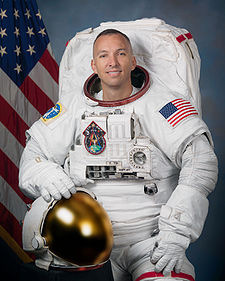Randolph James Bresnik
| Randolph James Bresnik | |
|---|---|
 Randolph James Bresnik | |
| Astronaut NASA | |
| Státní příslušnost | |
| Datum narození | 11. září 1967 (55 let) |
| Místo narození | Fort Knox, Kentucky |
| Předchozí zaměstnání | pilot |
| Hodnost | plukovník |
| Čas ve vesmíru | 149 dní, 12 hodin a 12 minut |
| Kosmonaut od | 2004 |
| Mise | STS-129 Expedice 52/53 (Sojuz MS-05/ISS) |
| Znaky misí | |
| Některá data mohou pocházet z datové položky. | |
Randolph James Bresnik (*11. září 1967 v Fort Knox, stát Kentucky, USA) je americký letec, důstojník a kosmonaut. Ve vesmíru byl v roce 2009 v rámci mise STS-129 a v roce 2017 jako velitel na ISS v Expedici 53.
Život
Studium a zaměstnání
Absolvoval střední školu Santa Monica High School v městě Santa Monica (1985), zejména matematiku studoval na The Citadel v Charlestonu (1989), letecké systémy na University of Tennessee v Knoxville. Studium ukončil v roce 2002.
Pracoval jako pilot v armádě na mnoha různých místech a s různými letadly. Nalétal přes 5000 letových hodin.
V letech 2004 až 2006 absolvoval výcvik budoucích kosmonautů v Houstonu, poté byl zařazen do tamní jednotky astronautů NASA.
Oženil se, jeho manželkou se stala Rebecca Burginová. Během pobytu na ISS se mu narodila dcera. Spolu vychovávají ještě adoptovaného syna.
Má přezdívku Randy.
Lety do vesmíru
Na oběžnou dráhu se v raketoplánu dostal jednou ve funkci letový specialista, pracoval na orbitální stanici ISS, strávil ve vesmíru 10 dní, 19 hodin a 16 minut. Absolvoval dva výstupy do volného vesmíru (EVA), kde strávil 11 hodin a 50 minut. Byl 506. člověkem ve vesmíru.
- STS-129 Atlantis (16. listopadu 2009 – 27. listopadu 2009)
- Expedice 52/53 (Sojuz MS-05/ISS) (28. července 2017 – 14. prosince 2017)
Odkazy
Externí odkazy
 Obrázky, zvuky či videa k tématu Randolph James Bresnik na Wikimedia Commons
Obrázky, zvuky či videa k tématu Randolph James Bresnik na Wikimedia Commons - Na webu Space
- Na webu MEK-Kosmo
Média použitá na této stránce
The Expedition 53 crew insignia
- The International Space Station is our launch pad into the future of human space exploration. Collectively, our world stands at the cusp of incredible developments as a spacefaring species. Onboard the space station we continue to evolve the technologies vital to the sustainment and longevity of humans in the harsh realities of living without gravity or the protection of our atmosphere. These self-sustaining or regenerative technologies continually developed aboard the space station not only improve life here on Earth, but they are essential to human beings existence beyond low-Earth orbit (LEO).
- The space station is the linchpin for this next great phase of development and is instrumental in expanding the use of space, not only as a worldclass science laboratory, but also as a destination for next-generation space vehicles. This journey beyond LEO is depicted in the Expedition 53 patch as we, the crew, will endeavor to accomplish the work that allows future missions to further explore our solar system. This journey will only be accomplished as an international team, represented by our multinational crew as well as by the many countries depicted on the globe.
- The myriad of stars represent the untold number of passionate and supremely dedicated people that endeavor across the planet daily to make the space station the amazing vehicle it is as well as prepare us for the next great steps forward in space exploration.
The Expedition 52 crew insignia
- Our planet is shown surrounded by an imaginary constellation shaped like a house, depicting the theme of the patch: “The Earth is our home.” It is our precious cradle, to be preserved for all future generations. The house of stars just touches the Moon, acknowledging the first steps we have already taken there, while Mars is not far away, just beyond the International Space Station, symbolized by the Roman numeral “LII,” signifying the expedition number.
- The planets Saturn and Jupiter, seen orbiting farther away, symbolize humanity’s exploration of deeper space, which will begin soon. A small Sputnik is seen circling the Earth on the same orbit with the ISS, bridging the beginning of our cosmic quest till now: Expedition 52 will launch in 2017, sixty years after that first satellite.
- Two groups of crew names signify the pair of Soyuz vehicles that will launch the astronauts of Expedition 52 to the Station.
Astronaut Randolph J. (Randy) Bresnik, mission specialist
For STS-129 the sun shines brightly on the International Space Station (ISS) above and the United States below representing the bright future of U.S. human spaceflight. The contiguous U.S., Rocky Mountains, and Great Desert Southwest are clearly visible on the earth below encompassing all the NASA centers and the homes of the many dedicated people that work to make our Space Program possible. The integrated shapes of the patch signifying the two Express Logistics Carriers that will be delivered by STS-129 providing valuable equipment ensuring the longevity of the ISS. The Space Shuttle is vividly silhouetted by the sun highlighting how brightly the Orbiters have performed as a workhorse for the U.S. Space Program over the past 3 decades. The Space Shuttle ascends on the Astronaut symbol portrayed by the Red, White and Blue swoosh bounded by the gold halo. This symbol is worn with pride by this U.S. crew representing their country on STS-129. The names of the crew members are denoted on the outer band of the patch. As STS-129 launches, the Space Shuttle is in its twilight years. This fact is juxtaposed by the 13 stars on the patch which are symbolic of our children who are the future. The Moon and Mars feature predominantly to represent just how close humankind is to reaching further exploration of those heavenly bodies and how the current Space Shuttle and ISS missions are laying the essential ground work for those future endeavors.




